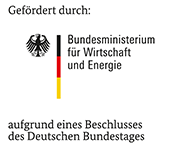
| Period: | 01.03.2010 - 31.12.2012 |
|---|---|
| Partner: | - |
| Funder: | Arbeitsgemeinschaft industrieller Forschungsvereinigungen e.V. |
| Project Manager: | Dr. Claudia Weidlich |
| Research Group: | Electrochemistry |
Aims
The Aim of this project is the development of electrochemically switchable membranes with variable separation properties. To achieve this, conventional membranes should be coated with conducting polymers, e.g. polypyrrole (PPy).
The properties of conducting polymers, e.g. structure, volumen, permselectivity and wettability, can be changed due to their polarisation.
The separation properties of ppy-coated membranes as well as their permeability for ions or pharmaceuticals can be controled by the polarisation of the conducting polymer.
Results
A method for coating membranes with polypyrrole (PPy) has been developed. Different membranes, such as microfiltration- as well as ion-exchanger membranes, have been coated with PPy to yield electrical conductivity of the membranes.
The coated membranes were investigated by cyclic voltammetry and scanning electron microscopy. The permeability and permselectivity of the coated membranes have been investigated. The results show that PPy can be tailored as cation- or anion-exchanger and its porosity can be controlled to avoid any impairment of the membrane by the polymer layer.
A microfiltration membrane coated with PPy with polystyrenesulfonate (PSS) counter ions works as an electrochemically switchable cation exchanger membrane. Cathodic polarisation yields in a decrease of the Ca-concentration in the filtrate due to adsorption of Ca cations by the PPy/PSS coating. During anodic polarisation the Ca-concentration in the filtrate is increasing due to desorption of Ca cations into the filtrate. These ion exchangeing properties can be observed during potentiostatic as well as galvanostatic polarisation.
The PPy-coated membranes can be applied as electrochemically switchable membranes with controllabel and variable separation properties.
Furthermore fouling caused by microorganisms can be reduced by electrochemical switching of the coated membranes (patent EP 1777250).
back
Das IGF-Vorhaben Nr. der Forschungsvereinigung DECHEMA e.V., Theodor-Heuss-Allee 25, 60486 Frankfurt am Main wurde über die AiF im Rahmen des Programms zur Förderung der industriellen Gemeinschaftsforschung (IGF) vom Bundesministerium für Wirtschaft und Energie aufgrund eines Beschlusses des Deutschen Bundestages gefördert.
Dr. Claudia Weidlich
Telefon: +49-(0)69 / 75 64-633
E-Mail: Weidlich
Electrochimica Acta, 2011, 56, 3481-3484 doi: 10.1016/j.electacta.2010.11.065